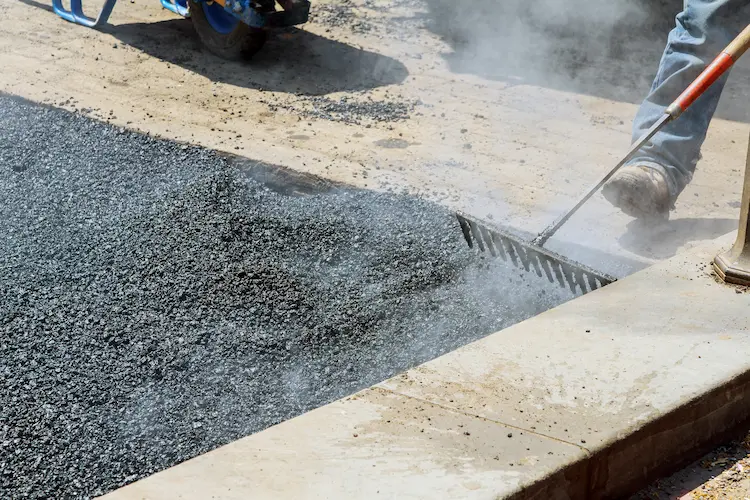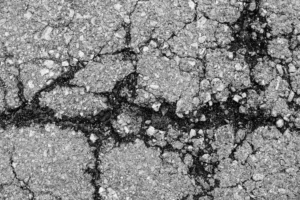If you want to keep your asphalt in top shape, you need to know its maintenance requirements.
Think of your asphalt as a fortress, needing constant protection to withstand the elements.
Regular cleaning, crack inspection, and sealcoating are just a few of the tasks that will keep your asphalt strong and durable.
By implementing a proactive maintenance plan, you can ensure that your asphalt remains safeguarded for years to come.
Key Takeaways
- Regular maintenance and cleaning, such as sweeping and power washing, are essential for preventing debris accumulation and maintaining the pristine appearance of the asphalt.
- Inspecting and repairing cracks and potholes promptly is crucial to prevent water infiltration and further damage to the asphalt.
- Applying sealcoating regularly helps protect the asphalt surface from water, UV rays, and chemicals, preventing cracks, potholes, and deterioration.
- Regular re-striping and marking of the asphalt surface enhance appearance, improve safety, and maintain functionality.
Regular Cleaning and Debris Removal
To keep your asphalt in good condition, you should regularly clean it and remove any debris. Regular sweeping is an essential maintenance task that helps prevent dirt, leaves, and other debris from accumulating on the surface. This debris can trap moisture and cause damage to the asphalt over time. Sweeping should be done at least once a week, or more frequently in areas with heavy foot or vehicle traffic.
In addition to regular sweeping, power washing can be used to remove stubborn stains and deep-seated dirt. Power washing involves using high-pressure water to effectively clean the surface of the asphalt. It’s important to use the appropriate pressure and cleaning solution to avoid damaging the asphalt during this process.
Inspecting for Cracks and Potholes
To effectively maintain your asphalt and ensure its longevity, you need to regularly inspect for cracks and potholes. These small imperfections may seem harmless, but if left unattended, they can quickly escalate into larger and more costly issues. Here are some key steps in inspecting for cracks and potholes:
- Visual Inspection: Take a walk along the asphalt surface and carefully examine for any visible cracks or depressions.
- Crack Sealing: Utilize specialized materials to fill and seal cracks, preventing water infiltration and further damage.
- Pothole Repair: Address potholes promptly by removing the damaged area, applying a suitable patching material, and compacting it properly.
- Surface Evaluation: Assess the overall condition of the asphalt, checking for signs of wear, oxidation, or deterioration.
- Professional Assistance: Consult with asphalt maintenance experts for a comprehensive evaluation and recommendations on maintenance strategies, including crack sealing and pothole repair.
Regularly inspecting for cracks and potholes and promptly addressing them through crack sealing and pothole repair will significantly extend the life of your asphalt surface and save you time and money in the long run.
Applying Sealcoating for Protection
To ensure the longevity of your asphalt surface, it’s important to regularly apply sealcoating for protection. Sealcoating provides numerous benefits, including protection against damaging elements such as water, UV rays, and chemicals. By creating a barrier on the surface of the asphalt, sealcoating prevents these elements from penetrating the pavement, reducing the risk of cracks, potholes, and other forms of deterioration.
When choosing sealcoating products, it’s crucial to select the right ones that are specifically designed for asphalt surfaces. Look for sealcoating materials that are made from high-quality ingredients, such as coal tar or asphalt emulsion. These products offer excellent durability and resistance to wear and tear. Additionally, consider factors such as the climate in your area and the level of traffic your asphalt surface experiences. This will help you determine the appropriate type and thickness of sealcoating to apply.
Regularly applying sealcoating to your asphalt surface won’t only enhance its appearance but also protect it from the damaging effects of weather and traffic. Make sure to follow the manufacturer’s instructions and apply sealcoating at the recommended intervals to maintain the integrity and longevity of your asphalt pavement.
Repairing Damaged Areas Promptly
Have you noticed any damaged areas on your asphalt surface that need prompt repair? It’s crucial to address these issues quickly to prevent further deterioration and potential safety hazards. Repairing cracks and filling potholes promptly will help maintain the integrity of your asphalt surface and extend its lifespan.
Here are some important factors to consider when repairing damaged areas:
- Identify the extent and severity of the damage, including the size and depth of cracks or potholes.
- Clean the damaged area thoroughly, removing any loose debris or vegetation.
- Apply a suitable asphalt repair product or patching material to fill the cracks or potholes.
- Compact the repair material to ensure a proper bond with the existing asphalt surface.
- Seal the repaired area to protect it from moisture and further damage.
Regularly Re-Striping and Marking
Keep your asphalt surface safe and well-maintained by regularly re-striping and marking it. Re-striping and marking your asphalt not only enhances its appearance but also improves safety by providing clear and visible guidance to drivers and pedestrians. It is important to ensure that the paint adhesion is strong, as it will prevent the markings from fading or peeling off prematurely. Conducting a traffic flow analysis can help determine the most effective placement of markings, ensuring that they are strategically placed to direct traffic and minimize confusion. Regularly re-striping and marking your asphalt surface helps maintain its functionality and enhances the overall safety of the area.
To emphasize the importance of this maintenance task, consider the following table:
| Benefits of Regular Re-Striping and Marking |
|---|
| Enhances visibility for drivers and pedestrians |
| Provides clear guidance for traffic flow |
| Reduces confusion and potential accidents |
| Improves overall safety of the area |
| Increases the lifespan of the markings |
Performing Regular Drainage Maintenance
Maintaining the integrity of your asphalt surface includes regularly performing drainage maintenance to prevent water damage and ensure optimal functionality. Proper maintenance of the drainage system is crucial to protect your asphalt pavement from the detrimental effects of water accumulation.
Here are five important tasks you should include in your regular drainage maintenance routine:
- Clearing debris and leaves from the gutters to prevent clogs.
- Inspecting downspouts for blockages and ensuring proper water flow.
- Checking for any cracks or damage in the drainage system and repairing them promptly.
- Cleaning and flushing out the drainage pipes to remove any sediment or buildup.
- Evaluating the slope and grading of the pavement to ensure proper water runoff.
Implementing a Proactive Maintenance Plan
Create a proactive maintenance plan to ensure the longevity and durability of your asphalt surface. By implementing preventive measures, you can significantly increase the long-term sustainability of your asphalt.
Regularly inspect your asphalt surface for signs of damage, such as cracks or potholes, and address them promptly.
Schedule routine sealcoating and crack sealing to protect against water infiltration and prevent further deterioration.
Additionally, consider implementing a regular sweeping and cleaning schedule to remove debris and prevent it from causing damage.
Regularly assess the condition of your asphalt and conduct necessary repairs and resurfacing as needed.
Conclusion
In conclusion, proper maintenance is crucial for safeguarding asphalt.
By regularly cleaning and removing debris, inspecting for cracks and potholes, applying sealcoating, repairing damaged areas promptly, regularly re-striping and marking, and performing drainage maintenance, the longevity and durability of the asphalt can be greatly enhanced.
Implementing a proactive maintenance plan ensures that potential issues are addressed before they become major problems.
By following these guidelines, you can ensure the longevity and structural integrity of your asphalt surfaces.



